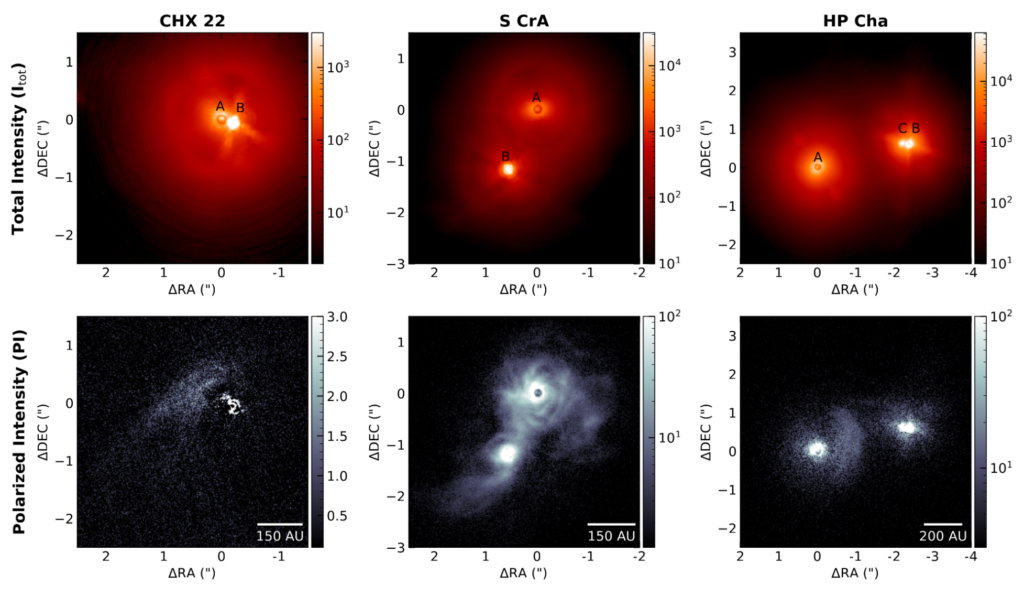Authors: Yapeng Zhang, Christian Ginski, Jane Huang, Alice Zurlo, Hervé Beust, Jaehan Bae, Myriam Benisty, Antonio Garufi, Michiel R. Hogerheijde, Rob G. van Holstein, Matthew Kenworthy, Maud Langlois, Carlo F. Manara, Paola Pinilla, Christian Rab, Álvaro Ribas, Giovanni P. Rosotti, Jonathan Williams
First Author’s Institution: Leiden Observatory, Leiden University, Leiden, The Netherlands
Status: Published in A&A [open access]
Stars, planets, moons, comets, galaxies – all twirl in the dance of the universe. But it takes two to tango, so naturally some astronomical objects go and find a partner.
Many stars are born in binary systems, some even join together in triplets, quadruplets, or even larger groups. Much like single stars, multiple systems can be accompanied by protoplanetary disks. Those disks consist of gas and dust and provide the environment for planet formation. In a binary system, there is more than one possible configuration: a disk could encircle one of the stars (called circumstellar disk), both stars (two circumstellar disks), or dance around the whole system (called circumbinary disk). There could even be a circumbinary disk present in addition to one or two circumstellar disks. Each one of those disks has the potential to form planets.
The formation of planets is greatly influenced by the shape and structure of the disk. This disk structure can be very different in binary or multiple systems than in disks around single stars. Therefore, the conditions for planet formation differ as well. One way to constrain planet formation in those systems is observing them. We only observe a system at the current moment in their time evolution, therefore it is preferable to find more than one system in different evolutionary stages.
Is it… DESTINY(S)?
The authors of today’s paper take that approach to investigate planet formation and present observations of never-before-seen disks in three multiple systems (i.e. two binary and one triplet system). The three systems have very different distances between the stars: 50 au, 200 au, and 500 au. This makes them perfect to compare to each other in order to investigate effects the binary separation might have on the disk.

The most compact system of the three is a binary system with 50 au separation between the two stars (left column in Figure 1). It shows a tail structure around both stars, but does not really own a full circumbinary disk. The authors of today’s paper argue that this is most likely not the original protoplanetary disk, but material that was captured by the system later on. The original disk was either already dispersed by winds, or truncated by the gravitational force of the other star.
The second system (middle column in Figure 1) is a binary system as well and has a separation of 200 au. Both stars carry a disk which are connected through streamers (flow lines out of gas and dust). Both disks individually show wild structures, just like a flowy dance dress in a lively dance. The structures occur mostly in spiral features, but the authors additionally extract a ring in one of the disks. The spiral features are a consequence of the disruption by the other star, the ring however can not be explained in the same way. The authors suspect another object of lower mass to be present, perhaps a planet causing the ring structure.
The third system is a triplet system and is the widest of the three with a separation of 500 au between the biggest star and the two others. The two others form their own little binary system, a so-called close binary. There are two disks present, one around the biggest star and one around the close binary. These disks are also connected with streamers, but show much less features than the second system.
The comparison of the three systems demonstrates that the closer a companion star is, the greater is the effect on the structures of the protoplanetary disk. The authors conclude that planet formation might be suppressed in close binary systems, but can occur “normally” in systems with large separations. With this study, we’re one step closer to understanding the dance of multiple systems. Let’s enjoy the show and let them have this dance.
Astrobite edited by William Balmer
Featured image credit: Figure 1 in today’s paper and David Hofmann on Unsplash




